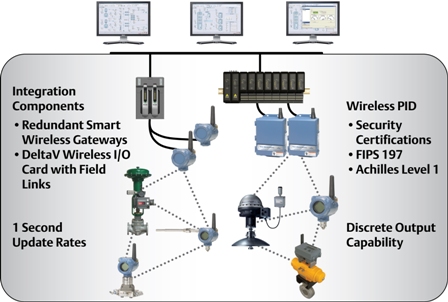As technology evolves, users are now moving beyond mainstream monitoring applications to wireless measurements for control in harsh and remote environments.

Emerson Process Management’s Smart Wireless technology is moving into more applications where implementing and maintaining a traditional wired network is too difficult or expensive. "Besides gaining cost-effective insights by using Smart Wireless to monitor processes and equipment, users can now also exploit the advantages of this technology for better control of difficult applications," said Bob Karschnia, vice president of wireless for Emerson Process Management.
One company gaining these advantages is Northstar Bluescope Steel, which replaced traditional wired instruments with Emerson’s Smart Wireless technology to improve furnace control at its mini-mill in Delta, OH. The mill’s old, hard-wired network had hundreds of wiring junctions and suffered frequent measurement failures in the harsh environment, with its high electromagnetic fields, flying slag, vibration, moisture, and temperatures as high as 3,000 °F. With wireless measurements, however, improved control and reduced downtime enabled the mill to boost production by as much as one batch per day, cut maintenance costs by $200,000 annually, and improve worker safety.
Major oil companies are also using Emerson’s Smart Wireless for steam-injection control on more than 2,300 remote wells that needed to be instrumented quickly to maximize field performance. Harsh environments including high ambient temperatures, sandstorms, no local power, and remote locations made traditional solutions unreliable, hard to maintain, or simply impractical. Emerson’s reliable, easy-to-implement wireless technology provided a cost-effective way to overcome these challenges quickly and with fewer potential points of failure than wired solutions. The resulting improved control has also enabled the companies to avoid costly and inefficient over-steaming.
"More and more users are finding that expanded use of wireless beyond simple monitoring applications enhances their ability to build and run safe, efficient, profitable facilities," said Karschnia. "It’s no wonder the technology has so rapidly entered the process-automation mainstream, with more than 1,400 sites already using wireless networks based on the IEC 62591 standard. The ease of adding measurements for control can save as much as 60% on installation time, and the flexible architecture makes it easy to accommodate late design changes. There are also fewer components to install and maintain, and fewer potential points of failure."
Emerson contends that continuing improvements to its wireless technology further strengthen the case for wider use beyond monitoring and into the realm of challenging control applications. In addition to one-second update rates and redundant gateways, the company’s offering includes the Rosemount 702 wireless transmitter that now provides discrete output as well as input capabilities for wireless networks. An enhanced PID algorithm is also available in the DeltaV digital automation system for optimized closed-loop control.
Moreover, cyber-security measures built into Smart Wireless technology have also recently been certified by the National Institute of Standards and Technology (NIST) to meet the requirements of Federal Information Processing Standard 197 (FIPS-197), and by Wurldtech for Achilles Level 1 Certification.
Edited by Peter Welander, [email protected]



